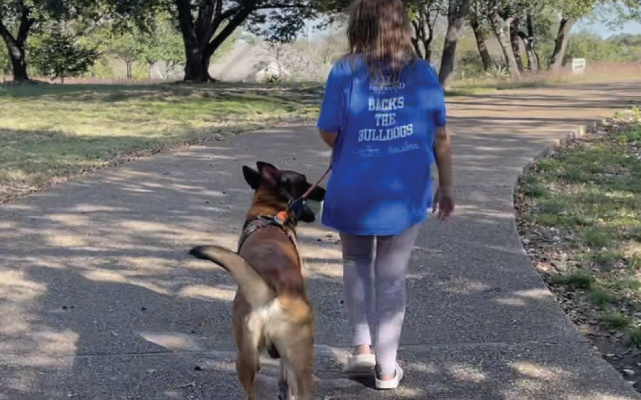Raising children is one of the most rewarding yet challenging experiences a parent can have. But what happens when parents take further measures to safeguard their families by having a protection dog?

A protection dog isn’t just any ordinary pet. They are trained to guard and deter any potential threats in the home. For families with young children, they can provide an extra layer of security and comfort. But it’s important to be aware that this comes with some added responsibility as well. In this blog post, we will talk about the benefits, safety considerations, and responsibilities for families living with a protection dog and young children.
Choosing the right protection dog for your family
When it comes to choosing the right protection dog for your family, there are several important considerations to keep in mind. First and foremost, it is essential to choose a protection dog that is well-suited to a family setting. This means choosing a dog breed that is known to be good with children and other animals while also being alert and protective. Some of the best protection dog breeds for families include the Dutch Shepherd and Belgian Malinois. These breeds are known for their loyalty, intelligence, and natural protective instincts, making them ideal for use as personal or family protection dogs.
When selecting a protection dog, it is also important to consider the specific area in which you live. Different breeds may be better suited to different climates and living conditions, so it is important to choose a dog that is likely to thrive in your particular environment. When it comes to living with a protection dog and young children, it is important to establish clear boundaries and expectations from the beginning. Teach your children to respect the dog’s space and boundaries, and make sure that they understand that the dog is there to protect them.
By choosing the right protection dog and establishing clear boundaries and expectations, families can enjoy the benefits of having a well-trained and reliable protector in their home.
The Importance Of Professional Training
When it comes to a fully-trained protection dog, professional training is crucial. These dogs are trained to protect their owners and their families, and it takes an experienced team with a comprehensive training program to teach them the necessary skills. Here are some reasons why professional training is important for a protection dog living with young children:
1. Safety: A well-trained dog can provide a sense of safety and security for the family. They know how to assess a situation and respond appropriately, and can provide valuable protection in the event of an intruder or threat.
2. Obedience: An untrained dog can pose a danger to young children, as they may not respond well to commands or boundaries. A protection dog that has undergone professional training, however, will have the skills and discipline to follow instructions and be a well-behaved member of the family.
3. Socialization: Professionally trained protection dogs include socialization skills. This helps teach the dog when to be assertive in protecting their family, but also when to be gentle around young children.
4. Expertise: Guardian Malinois understands the unique skills necessary for a protection dog living with young children. We teach the dog to recognize the difference between play and danger, and how to respond accordingly.
Debunking common myths and concerns about living with a protection dog
Living with a protection dog is a big responsibility, especially when you have young children in the house. It’s important to educate yourself about the realities of living with a protection dog and debunk some of the common myths and concerns associated with it.
1. Myth: Protection dogs are always aggressive towards children.
This is a common myth that is simply not true. Protection dogs are trained to protect their owners, but they are also trained to distinguish between friend and foe. With proper training, a protection dog can be gentle and friendly with children, and can even act as a loyal companion and playmate.
2. The so-called junkyard dog
There is an old trope of the so-called junkyard dog that has persisted in popular culture for decades. These are untrained dogs of any breed that are kept as guard dogs, often chained up in junkyards or other hostile environments. However, this is not the norm for properly trained protection dogs. Protection dogs are typically bred from specific breeds known to have protective tendencies, such as German Shepherds, Dutch Shepherds, and Belgian Malinois. These dogs are then trained to obey commands and to only attack in certain situations.
3. Concern: What happens if the protection dog attacks a child?
This is a common area of concern for parents who wish to have a protection dog in their home. However, with proper training and socialization, this is a highly unlikely scenario. Protection dogs are trained to only attack when commanded or when they perceive their owner to be in danger. In addition, they are trained to distinguish between friend and foe and to ignore distractions such as other animals or children playing.
Integrating your protection dog into your home environment
When bringing a protection dog into your home that also has young children, it is important to take the necessary steps to integrate the dog into your home environment. This will help create a safe and comfortable living space for both the dog and your family.
Create a designated safe space for the dog
One of the first steps in integrating a protection dog into your home is to create a designated safe space for the dog. This can be a separate room or area in the house where the dog can retreat to when feeling overwhelmed or when the children are playing in areas that the dog should avoid. This designated space should be an area where the dog can relax and feel safe.
Teach your children how to interact with the dog
It is important to teach your children how to interact with the protection dog in a safe and respectful manner. This will help reduce the risk of any accidents happening and will help the dog to feel more comfortable around the children.
The Role of a protection dog in female crime prevention
Protection dogs can play an important role in female crime prevention. The undeniable disparity between male and female crime victimization calls for proactive measures. Here are a few ways Guardian Malinois protection dogs can help protect women and children.
Early Detection:
According to a study by the Swedish National Council for Crime Prevention, dogs have been shown to detect danger before humans in many cases. A protection dog can be trained to detect potential danger, alerting their owners and giving them valuable time to react and protect their family.
Intimidation Factor:
One of the primary roles of a protection dog is to act as a deterrent to potential intruders. Guardian Malinois protection dogs are often trained to show their teeth, growl, and bark on command, which can be a huge deterrent to someone looking to commit a crime.
Increased Safety Measures:
Guardian Malinois protection dogs provide an added layer of safety to any home with young children. These dogs are specifically trained to protect the people they are assigned to, making them a valuable addition to any family.
Protection Against Female Murder Victims:
According to the FBI, females are more likely to be victims of murder by someone they know. An elite protection dog can provide a sense of security and protect a female from an attacker they may know.
Protection Against Female Crime Victims:
Female crime victims are often subjected to physical violence and sexual assault. An elite protection dog can provide a sense of security and deter potential attackers from committing a crime.
The benefits of living with a protection dog for peace of mind
Living with a protection dog can offer numerous benefits for families, especially those with young children. Here are some of the ways a protection dog can provide peace of mind for the whole family:
1. Deterrence: A protection dog is a visible sign of security for your household. Due to their imposing presence, potential intruders are less likely to target a home with a protection dog. According to experts, protection dogs serve as a valuable deterrent against burglars and other criminals.
2. Early detection: Protection dogs are trained to use their keen senses to pick up on suspicious activity and alert their owners. A protection dog’s heightened sense of smell, hearing, and sight can provide early warning signals when there’s someone approaching the house, which can give family members more time to react and protect themselves.
3. Loyal companionship: Protection dogs are not mere security devices, they can become valuable members of the family. These dogs are trained to be affectionate and loyal companions to their owners, which can help to reduce stress and provide emotional support.
4. Increased sense of security: With a protection dog at home, parents can have greater peace of mind knowing that their children are safe. Protection dogs are trained to defend their owners against potential threats, which can alleviate anxieties and provide reassurance.
5. Enhanced social skills for children: Living with a protection dog can help children learn important social skills, such as respect, empathy, and responsibility. These dogs require regular exercise, grooming, and attention, which can help children develop a sense of empathy and encourage them to take responsibility for another living creature.
6. Positive influence on children’s behavior: Studies have shown that owning a protection dog can have a positive influence on children’s behavior. Children living with dogs have been found to be less anxious and more outgoing in social situations.
7. Best Protection: A well-trained protection dog can play a big role in providing safety and security for your family. A protection dog is trained to assess situations and make decisions in seconds they can be a valuable asset in case of any emergency.
In conclusion, having a protection dog in a household with young children can offer an extra layer of safety and peace of mind for parents. However, it’s important to understand the responsibilities that come with it and ensure that proper training and socialization are implemented for both the dog and the children. By following the tips we’ve outlined in this guide, parents can create a harmonious and safe environment for their family. If you’re interested in learning more about protection dogs or need help training your furry companion, don’t hesitate to contact us today!

